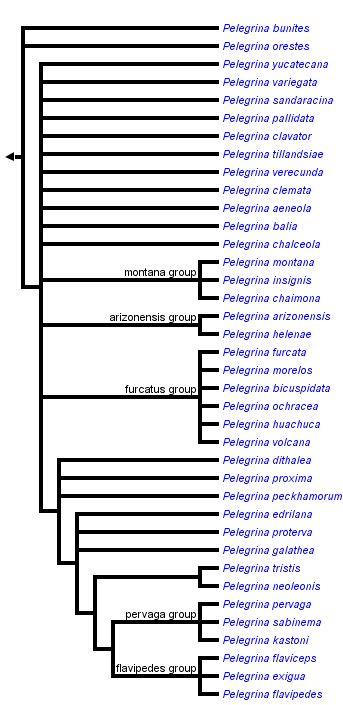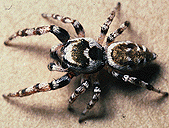Pelegrina
Wayne Maddison


This tree diagram shows the relationships between several groups of organisms.
The root of the current tree connects the organisms featured in this tree to their containing group and the rest of the Tree of Life. The basal branching point in the tree represents the ancestor of the other groups in the tree. This ancestor diversified over time into several descendent subgroups, which are represented as internal nodes and terminal taxa to the right.

You can click on the root to travel down the Tree of Life all the way to the root of all Life, and you can click on the names of descendent subgroups to travel up the Tree of Life all the way to individual species.
For more information on ToL tree formatting, please see Interpreting the Tree or Classification. To learn more about phylogenetic trees, please visit our Phylogenetic Biology pages.
close boxIntroduction
Among the commonnest jumping spiders of North America are the medium sized vegetation dwellers of the genus Pelegrina. The males are typically brown and white striped; the females mottled or spotted of grays and browns. The sides of the face of males ("cheeks") often have an extra white stripe, the embolus is broader at the tip than in many other dendryphantines, and the epigynum has robust flaps covering the openings. Most of these species until recently were placed in the genus Metaphidippus.If you want to see a graphical overview of diversity of Pelegrina, the gallery has pages with compiled illustrations of male faces, male palpi, female abdomens, and female epigyna
Much of the Pelegrina section of the Tree of Life is based on the revision by Maddison (1996). That revision contains many more illustrations, keys and full descriptions.
Characteristics
Males typically brown with longitudinal bands of white scales on either side of the carapace and abdomen. The inverted white V-shaped marking on the forehead that contacts the anterior median eyes distinguishes Pelegrina from most other dendryphantines, though it is not present in all Pelegrina. Legs often with annulate markings. The relatively wide embolus with the tip expanded retrolateral to its opening and bearing two rami is generally a good diagnostic feature for the genus, but it is absent in a number of species. Tibial apophysis stout; just ventral to apophysis is usually a ridge, developed into a second apophysis in some species (furcata group), or a wide flange in other species (arizonensis group). Females gray, yellow or brown with mottled markings of four prominent pairs of pale spots on the abdominal dorsum. Epigynal openings relatively long. Among small dendryphantines, the species of Pelegrina have perhaps the best developed epigynal flaps, which are the teardrop-shaped lateral rims of the openings. The flaps are usually convex and overlap the medial rim of opening. All species of Pelegrina examined have the same chromosome complement, 2n(male) = 26 + XXO, as is prevalent throughout the family.The following characters support the monophyly of the genus, though none provides a simple, strict delimitation (Maddison, 1996). Some of the characters delimit a group slightly smaller than the genus, others a group slightly larger. Thus, each character provides only indirect and partial evidence for monophyly.
- Embolus with two terminal rami retrolateral to opening. The sperm duct opening lies on the prolateral side of the embolus, often below the tip. Retrolateral to the opening are two rami, one just distal to the opening; the other often elongate and forming the retrolateral tip of the embolus.
- Hematodocha of embolus bulges as far distally as the base of the erect portion of the embolus.
- Epigynal flaps well developed, long and wide, and not descending into the opening posteriorly.
- Wrinkles present on anterior margin of male cheliceral fang.
- Distinct cheek bands on the male face.
- An inverted V-shaped mark of pale scales on the forehead, contacting the AME.
- Male courtship with prolonged "crouch" display.
- Ridge under tibial apophysis.
References
Maddison, W.P. 1996. Pelegrina Franganillo and other jumping spiders formerly placed in the genus Metaphidippus (Araneae: Salticidae). Bulletin of the Museum of Comparative Zoology. l54(4): 215-368.
Title Illustrations

Pelegrina dithalea Maddison
| Copyright |
© 1994-1995 Wayne Maddison

|
|---|
About This Page
Included on this page is text from Maddison, W.P. 1996. Pelegrina Franganillo and other jumping spiders formerly placed in the genus Metaphidippus (Araneae: Salticidae). Bulletin of the Museum of Comparative Zoology. l54(4): 215-368. This text is copyright © 1996 The President and Fellows of Harvard College
Wayne Maddison

University of British Columbia, Vancouver, British Columbia, Canada
Correspondence regarding this page should be directed to Wayne Maddison at
Page copyright © 1995 Wayne Maddison
All Rights Reserved.
Citing this page:
Maddison, Wayne. 1995. Pelegrina. Version 01 January 1995 (under construction). http://tolweb.org/Pelegrina/2902/1995.01.01 in The Tree of Life Web Project, http://tolweb.org/







 Go to quick links
Go to quick search
Go to navigation for this section of the ToL site
Go to detailed links for the ToL site
Go to quick links
Go to quick search
Go to navigation for this section of the ToL site
Go to detailed links for the ToL site